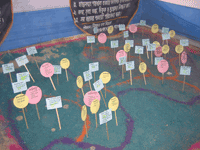‘Community-led total sanitation’ was pioneered in Bangladesh by Kamal Kar (a development consultant from India) and the Village Education Resource Centre while they were evaluating an NGO’s traditional subsidised sanitation programme. They wanted to convince the NGO to stop subsidising toilet construction because subsidies in the past had not led to community ownership and toilet usage. Instead, they suggested that the NGO should encourage people to help themselves. They developed an approach called Community-led total sanitation (CLTS) and it spread fast within Bangladesh among both Bangladeshi and international NGOs.
At the heart of the CLTS approach is a shift away from subsidising toilet construction for individual households towards changing attitudes and behaviour of the whole community in order to stop open defecation. This is achieved through mobilising the community. As a result, community members use their own initiatives to build latrines. CLTS does not identify standards or designs for latrines, but encourages local creativeness. This leads to greater ownership, affordability and therefore sustainability. The box below compares the CLTS approach with the traditional approach to sanitation.
| Traditional approach to sanitation | Community-led total sanitation | |
| Starts with: | Things e.g. latrines | People |
|
Core activity: |
Constructing latrines | Inspiring people and helping them move towards action |
| Latrines designed by: | Engineers | Community innovators |
| Number of designs: | One or a few | Many |
| Materials: | Cement, pipes, bricks | Often initially bamboo, jute bags, plastic, tin |
| Cost: | High | Can be very low |
| Indicators: | Latrines constructed | Communities free of open sanitation |
| Sustainability: | Partial and patchy | Very high so far |
| Key motivation: | Subsidy | Self-respect |
| Coverage/usage: | Partial | Total |
| Who benefits?: | Usually the better off | All including the poorest |
Methodology
The facilitator’s job is not to convince the community to stop open defecation and start constructing toilets. Instead, it is to assist the community in analysing the local sanitation situation. This generally triggers a sense of disgust and embarrassment and motivates the community to stop open defecation. It is important that the facilitator does not preach or tell people what to do, but instead asks simple questions to draw people’s attention to the issues.
Throughout the process, community members are encouraged to use local terms to describe faeces rather than the polite terms, in order to break the taboos surrounding sanitation.
The following are some of the ways used to trigger CLTS:
Transect walk
The process often starts with an informal talk with a few community members during a walk through the village (a ‘transect walk’). During the walk, areas of open defecation are pointed out as well as different types of latrines currently in use. It is important to stop in the areas of open defecation and spend time there asking questions. Having their attention drawn to the unpleasant sight and smell by a visitor to the community is a key factor in triggering mobilisation.
Once the interest of a few community members has been captured, the process continues with all community members.
Mapping of defecation areas









